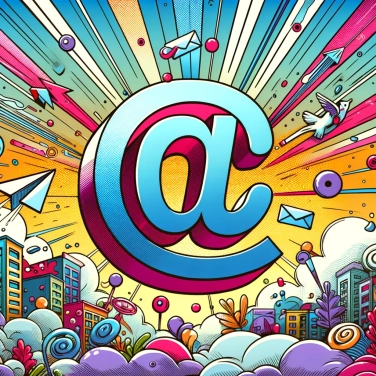The symbol '@' is used in computing to designate an email because it represents the preposition 'at' in English, meaning 'chez' in French. Thus, the email address is composed of the user's identifier followed by '@' and the domain name to which the message should be directed.

The symbol @ is older than we think. Some trace its origins back to the Middle Ages, where it served as a commercial abbreviation for the Latin terms "ad" or "à," meaning "at the price of" to note merchant rates. Another hypothesis connects it to the Arab world, claiming that the sign derives from a medieval calligraphic notation. However, many lean towards the European route, particularly Italian or Spanish, where @ indicated a unit of measurement called the arroba. With global trade, this small symbol spread, crossing the centuries until it subtly landed on our keyboards. Its current use for email addresses naturally stems from this heritage, simply expressing the idea of a recipient "at" or "to."
It is American engineer Ray Tomlinson who is credited with the introduction of the symbol @ in computing in the early 1970s. Looking for a simple separator character in email addressing, he naturally chose this original symbol since it was rarely used elsewhere, and thus less prone to confusion. The @ allowed for a clear identification of the user and the host computer to which the message was intended, in the form user@machine. This choice was quickly adopted massively in ARPANET, the precursor network of the Internet, and soon became a universal standard for designating email addresses. Today, this character is closely linked to our digital identity and is an integral part of computer pop culture.
The symbol @ simply separates the email address into two parts: on one side, there is the username (your personal identifier or nickname), and on the other side, the domain name (the server that hosts your mailbox). Thanks to @, the server knows immediately where to send your email. For example, in an address like alice@example.com, @ clearly indicates that the message for alice is to be delivered to example.com. Without this little character, it would quickly become total chaos: servers would have no idea how to manage all the messages that are constantly circulating on the Internet!
The symbol @ has become a true cultural and digital emblem. It directly evokes the idea of connection, sharing, and the virtual world. Almost instinctively, typing @ today means creating a username on social networks or connecting people via email all over the world. It is so ingrained in everyday life that it is even adopted by artists or brands, asserting its place in popular culture. It has also become synonymous with modernity and dynamism, to the point that it appears in many common expressions or in the names of certain tech companies. In everyday language, some even colloquially refer to it as the at sign, proving that it has evolved from a simple character to a true star of the digital alphabet!
The symbol '@' is believed to have appeared as early as the Middle Ages, used by European merchants to indicate the unit price (for example: 2 units @ 3 euros each).
The first email in history containing the '@' symbol was sent by Ray Tomlinson in 1971, thereby permanently linking this symbol to the world of computing and the Internet.
In France, before the term 'arobase' became commonly adopted, this symbol was also referred to as 'escargot' due to its spiral shape.
Today, the symbol '@' is also widely used on social media to identify or directly mention a user (for example: @username).
Its popularity primarily stems from its ubiquity in daily digital exchanges and its visually identifiable nature. Symbolizing the direct connection between individual and server, '@' has become emblematic of the digital age.
Indeed, '@' is used both on social media (Twitter and Instagram, for example, to mention users) and in various programming languages where it has specific functions, such as annotations in Java or decorators in Python.
No, a valid email address requires the use of the '@' symbol to explicitly distinguish between the user's name and the corresponding mail server.
Sure! Here’s the translation: "Yes, the symbol '@' has different expressive names depending on the cultures: 'at' in English, 'arobase' in French, 'chiocciola' (snail) in Italian, and 'Klammeraffe' (spider monkey) in German."
Ray Tomlinson, an American engineer, is recognized for introducing the '@' symbol in email addresses in 1971 to separate the user's name from the host computer's name.

No one has answered this quiz yet, be the first!' :-)
Question 1/6